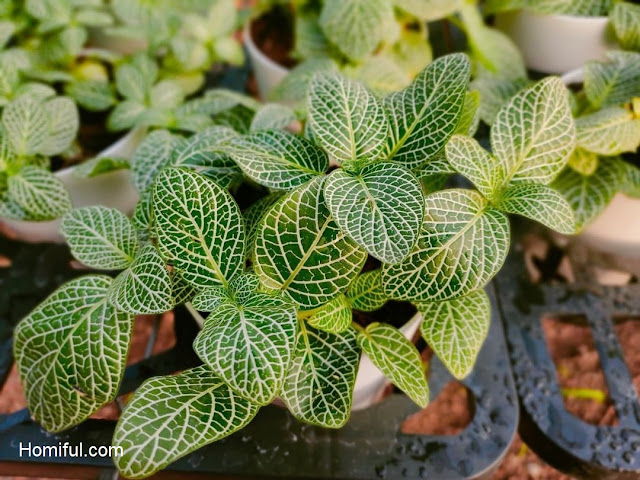 |
| Fittonia Guide: How to Grow and Care For Nerve Houseplant |
Homiful.com -- Nerve plant (Fittonia spp.) is a spreading evergreen perennial with beautifully veined, deep-green, oval leaves that is typically grown as a houseplant. Although silvery-white veins are the most common, you can also find variations with veins in red, pink, white, and green. If you're interested, you may read these "Fittonia Guide: How to Grow and Care For Nerve Houseplant" below.
Nerve Plant Care
 |
| @ugaoo |
Fittonia nerve plant prefers well-drained moist soil that is not very wet. Water moderately and allow growing nerve plants to dry between waterings. To avoid shock, water the plant with room temperature water.
The Fittonia nerve plant, which grows 3 to 6 inches (7.5-15 cm) by 12 to 18 inches (30-45.5 cm) or longer, tolerates strong light to shade situations but thrives in bright, indirect light. Growing nerve plants should be kept in a warm environment, away from drafts and water that is too cold or hot.
Variety of Nerve Plant
 |
| @amazing__plants |
'Argyroneura': Deep-green leaves with silver-white veins
'Pearcei': Deep-green leaves and reddish veins
'Frankie': Light pink and green leaves
'Fortissimo': Green foliage and red and pink veins
'Red Star': Boasts bright and cheery pink-red veined leaves
Pruning
 |
| @equafloraoficial |
Nerve plant grows swiftly in the correct conditions, and if the stems become lanky, nipping off the tips will keep the growth full and bushy. Pinching off the buds will also help maintain the foliage full because the blooms are insignificant and dull.
Propagating Nerve Plant
 |
| @terrarium.line |
Taking stem-tip cuttings is the most successful approach to propagate nerve plants; sowing seeds is ineffective.
1. Make stem-tip cuttings at an angle with clean, sharp garden shears. To achieve the greatest results, include at least two growth nodes on the bottom of the cutting.
2. Bury the cutting's bottom in a pot filled with a peat-based soil mix. It is not normally required to use a rooting hormone, but if your conditions are less than optimal (too dry or too chilly), rooting hormone may boost your chances of success.
3. Once the cutting has been potted, keep the soil moist but not wet. Roots ought to appear within two to three weeks.
Fittonia will thrive in any regular potting soil mix and houseplant pot with bottom drainage holes. Repot once a year in the spring or early summer, using fresh potting soil to avoid soil compaction and waterlogging.
Common Pests
 |
| @unikgardenandbeyond |
Fungus gnats, mealy bugs, and aphids are examples of insect pests. Infestations should be treated quickly with an insecticidal oil, such as neem oil, and damaged plants should be segregated to prevent the bugs from spreading to other indoor plants.
Common Problems with Nerve Plant
 |
| @shelleys.indoor.jungle |
Fittonia has many of the same problems as other tropical houseplants. Nerve plants may appear to be dying, yet changing their surroundings can save them.
Yellowing Leaves : Too much water causes the leaves to become yellow. To avoid wet soil, use a pot with drainage holes.
Leaf Fall : Leaf drop is typically caused by cold temperatures or drafts. Try to replicate the tropical conditions in which this species flourishes natively.
Dry, shriveled leaves : This usually means that the plants aren't getting adequate humidity or are getting too much direct sunlight. In the winter, when humidity levels can drop dramatically, use a room humidifier. Keep your nerve plant away from bright light.
Like this article? Don't forget to share and leave your thumbs up to keep support us. Stay tuned for more interesting articles from us in the future!
For those of you looking for a minimalist home design that ranges from simple to modern. Please leave your message and comments on Home Lovers on Facebook.
This article should be useful for those of you looking for design ideas and house plans.
Hopefully, you will find it easier to create your ideal home.
Don't forget to share it with your friends and family so that it can help others.
Author : Rieka
Editor : Munawaroh
Source : Various sources
Homiful.com is a collection of minimalist home designs and floor plans ranging from simple to modern. There are also several home decorating tips and tricks in various themes. Our main theme is the design and layout of the house, as well as the inspiration for the living room, bedroom, family room, bathroom, house prayer room, house terrace, and child's bedroom.


